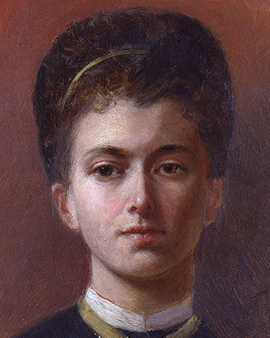


The British painter Lady Butler was born as Elizabeth Southerden Thompson in Switzerland. However, she spent most of her childhood in Italy, where she probably began her artistic education at the age of 16. About four years later the family moved to London, where she studied at the Female School of Art. There she met the critic John Ruskin and the painter Sir John Everett Millais, among others. Ruskin was an admirer of her work. Butler had forced him to admit that women could also paint. After three years Lady Butler returned to Italy with her family and they settled in Florence. She was accepted at the Accademia de Belle Arti and worked under the guidance of the Italian artist Guiseppe Bellucci.
Butler painted mainly religious motifs at the beginning of her career. This changed in the 1970s when she moved to Paris. She got to know the works of the military artists of Jean Louis Ernest Meissonier and Jean Baptiste Edouard Detaille. Although she herself had no connection to the military at that time, her fascination with this subject began. She felt that this genre was underrepresented in her home country Great Britain. From then on she painted almost exclusively military scenes. But unlike other artists, Butler did not concentrate on the depiction of battle scenes or the heroics of individual officers. Her works were more about the simple soldiers, their courage but also their exhaustion and despair. Often the men could be seen either just before the beginning or at the end of a battle. Butler avoided direct battle scenes in her paintings for the most part, as well as the depiction of enemy soldiers. This hit the nerve of the time and was entirely in keeping with the taste of the burgeoning patriotism in the British Empire. The enthusiasm for her paintings was partly due to her talent and the new way she portrayed them. But the fact that she was a young and attractive woman also played an important role. For she did not at all correspond to the typical image of a military painter of that time.
Some of her most famous works "Missing" or "The Roll Call" were exhibited at the Royal Academy. However, she was not accepted as the first female associate member of the Royal Academy, apart from the two co-founders Mary Moser and Angelica Kauffmann. At the age of 31 she married the distinguished Lieutenant General Sir William Francis Butler and was given the name Lady Butler, Elizabeth Southerden. She accompanied her husband to Egypt and Palestine, where she continued to paint and write a book. The couple had six children. When her husband retired from military service, the family moved to Ireland. Lady Butler continued to paint military scenes until the end of her life, although, influenced by her husband, she began to doubt the ideology of the colonial empire.

The British painter Lady Butler was born as Elizabeth Southerden Thompson in Switzerland. However, she spent most of her childhood in Italy, where she probably began her artistic education at the age of 16. About four years later the family moved to London, where she studied at the Female School of Art. There she met the critic John Ruskin and the painter Sir John Everett Millais, among others. Ruskin was an admirer of her work. Butler had forced him to admit that women could also paint. After three years Lady Butler returned to Italy with her family and they settled in Florence. She was accepted at the Accademia de Belle Arti and worked under the guidance of the Italian artist Guiseppe Bellucci.
Butler painted mainly religious motifs at the beginning of her career. This changed in the 1970s when she moved to Paris. She got to know the works of the military artists of Jean Louis Ernest Meissonier and Jean Baptiste Edouard Detaille. Although she herself had no connection to the military at that time, her fascination with this subject began. She felt that this genre was underrepresented in her home country Great Britain. From then on she painted almost exclusively military scenes. But unlike other artists, Butler did not concentrate on the depiction of battle scenes or the heroics of individual officers. Her works were more about the simple soldiers, their courage but also their exhaustion and despair. Often the men could be seen either just before the beginning or at the end of a battle. Butler avoided direct battle scenes in her paintings for the most part, as well as the depiction of enemy soldiers. This hit the nerve of the time and was entirely in keeping with the taste of the burgeoning patriotism in the British Empire. The enthusiasm for her paintings was partly due to her talent and the new way she portrayed them. But the fact that she was a young and attractive woman also played an important role. For she did not at all correspond to the typical image of a military painter of that time.
Some of her most famous works "Missing" or "The Roll Call" were exhibited at the Royal Academy. However, she was not accepted as the first female associate member of the Royal Academy, apart from the two co-founders Mary Moser and Angelica Kauffmann. At the age of 31 she married the distinguished Lieutenant General Sir William Francis Butler and was given the name Lady Butler, Elizabeth Southerden. She accompanied her husband to Egypt and Palestine, where she continued to paint and write a book. The couple had six children. When her husband retired from military service, the family moved to Ireland. Lady Butler continued to paint military scenes until the end of her life, although, influenced by her husband, she began to doubt the ideology of the colonial empire.
Page 1 / 1






